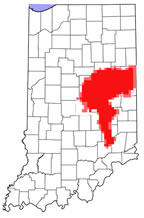Tri-County Industrial History
Madison, Henry and Delaware Counties
|
Indiana Gas Boom... Most of east central Indiana's early factories (Steel, Glass and Brick products) owe their existence to the gas boom that took place in here.  The Gas Boom was a period of active drilling and production of natural gas in the Trenton Gas Field,
in the US state of Indiana and the adjacent northwest part of Ohio. The boom began in the early 1880s and lasted into
the early twentieth century.
The Gas Boom was a period of active drilling and production of natural gas in the Trenton Gas Field,
in the US state of Indiana and the adjacent northwest part of Ohio. The boom began in the early 1880s and lasted into
the early twentieth century.When the Indiana natural gas belt was discovered, the citizens were unaware of what they had found; nearly a decade passed without action to recover the resource. Once its significance was realized, further exploration showed the Indiana gas belt was the largest deposit of natural gas discovered until then. In addition to the massive quantity of natural gas, in the 1890s developers discovered that the field also contained the first giant oil reserve found in the United States, with an estimated one billion barrels of oil. The resource was rapidly tapped for use. Because the gas was being wasted in use, the Indiana General Assembly attempted to regulate its use. In a series of cases, the Indiana Supreme Court ruled against the state's attempt at regulation, and waste continued. The poor understanding of oil and gas wells at the time led to an estimated 90% of the natural gas being lost into the atmosphere or misused in large quantities. By 1902 the yield from the fields began to decline, leading to a switch to alternative forms of energy. With most of the gas removed from the field, there was no longer enough pressure to pump the oil out of the ground. An estimated 900 million barrels (140,000,000 m3) of oil remain in the field. Advancements in artificial lift technology have led to extraction of some of the oil, but at a considerably slower rate and higher cost than most fields. The Trenton Gas Field is located in east central Indiana and the most western portion of west central Ohio. The field was discovered in 1876, but the size and magnitude of the field was not known until the 1880s. The field was the largest natural gas discovery up to that time, containing over 1 trillion cubic feet of natural gas. The field also contained the first giant oil reserve discovered in the United States with an estimated 1 billion barrels of oil. The discovery began the Indiana Gas Boom. Almost all of the natural gas was removed from the field by 1910, but only about 10% of the oil was removed at that point. The lack of pressure caused by the removal of the gas led to complete stop of oil production, even though an estimated 900 million barrels of oil remained in the field. Beginning in the late 20th century, oil production resumed at a slow pace after advances in artificial lift technology |